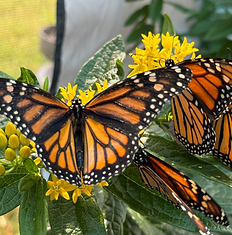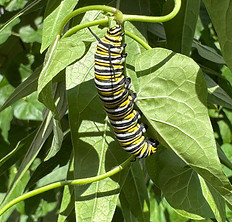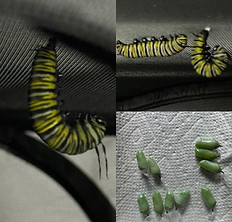
Caterpillar Care Instructions


Painted Lady Butterfly
Vanessa cadui
If your caterpillars were shipped to you, open the lid and check them when they first arrive. They may need time to acclimate after their travels, so do not be alarmed if they don’t move. Make sure you put the paper and lid back in place.
You should not open the cup again until all caterpillars have formed their chrysalis.
Keep the cups indoors at room temperature and out of direct sunlight. Your caterpillars have more than enough food, air, and space to make it through to pupation.
Once they have all pupated, wait 24 hrs then remove the lid and paper from the cup. Hang the paper in your pop up with a safety pin. It is recommended to pin them to the top so they hang as they did in their cup. Lightly mist the chrysalides daily so they won’t dry out.
When your butterflies emerge, their wings will be crumpled and wet. They need time to let their wings set. If you don’t have nectar to feed the butterflies, you should release them within a day or two when the outside temperatures are above 65 degrees and it is not raining.
Your cup and lid are recyclable, but check with your local recycling service to confirm it can be accepted in your curbside pick up.
Please contact us with any questions you may have about raising your caterpillars.
All butterflies and caterpillars are ethically sourced and well cared for.



Monarch Butterfly
Danaus plexippus
Caterpillars will eat and grow through 5 instars before they reach roughly 1 inch in length and pupate. Between each instar, they will stop eating, attach themselves to a surface, go still, and molt. Typically, they eat their shed skin but leave their old head capsule. You can tell if a caterpillar is about to molt by gently tapping their little back end. If they refuse to pick up those back feet, let them be! You can transfer caterpillars to a mesh pop-up cage around the third instar stage (about half an inch long). You'll need to empty frass from their container and use a clean paper towel to wipe away any residue. Do not use any cleaners or disinfecting wipes! These could kill the caterpillar.
When caterpillars are ready to pupate, they will attach themselves to the top of their enclosure, firmly planting their very back feet to the surface. They will stay that way for a day or so before letting go of the surface with their other feet to hang in a "J" shape. It's important not to touch them during this time. They will eventually molt again, revealing their pupal form, and then they'll condense themselves down into the usual pupal form.
The pupa will become translucent, revealing the adult butterfly inside when it's close to eclosing (emerging from the chrysalis). If you see the white dots on the butterfly's body and the orange wings clearly, check back often so you can witness the butterfly eclose. If the pupa is fully darkened without showing the orange of the wings for a few days, the pupa is likely dead.
When they do, they need to hang to inflate their wings and allow them to harden in the right shape. Do not disturb them when their wings are wet. It will take several hours before they might be dry enough for the butterfly to attempt to fly.
Your butterfly needs to eat within a day after eclosion. There are numerous options for feeding butterflies. Blinque's creates our own artificial nectar using a recipe available in our blog section of the website. Cut fruit can also be offered.
Adult Monarchs live for a few weeks to a few months, depending on the generation. The last generation of the Summer will migrate and live the longest. The other generations do not live as long. It's important to release your butterfly during a warm, sunny day. The temperature need to be above 55° F or it will be too cold for them to fly.
There are numerous diseases that caterpillars could develop. The best way to prevent this is to feed them safe food, remove old food before it can mold, and clean their frass at least daily. Sick caterpillars might change color, move strangely, or become very weak. If you suspect your caterpillar is ill, document the symptoms and contact us. The more information and images provided to us, the more likely we are to identify the problem.
Reminders on Feeding Caterpillars:
• Younger caterpillars need younger milkweed leaves.
• Rinse off plant material and pat it dry before giving it to caterpillars.
• Monarchs will eat more and more as they grow.
• Check on them at least twice per day to be sure they still have food.
• Dried-out or withered plant material should be replaced.



